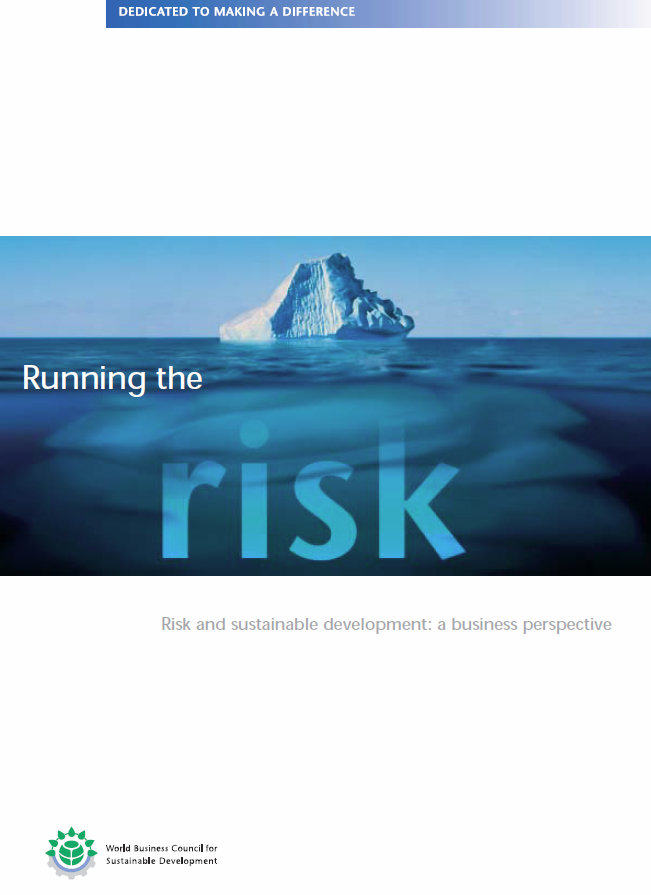
As individuals, we all have different attitudes to the risks of everyday life. Those attitudes have changed significantly over the generations as society has become more inter-connected. Globalization has prompted a shift in our concerns about risk from ‘local’ to ‘global’; indeed, as we enter the 21st century, we are faced with mega risks of a kind that society has never previously had to deal with.
The way corporations view risk has changed in the same way. There is a new recognition among companies that the achievement of their objectives depends on being able to deal with risks of a more ‘systemic’ nature. These are risks that cannot be tackled in isolation from each other, and which need to be addressed through an alliance of business and society working in unison. Achieving sustainable development falls squarely into this category.
While corporate actions in meeting societal needs for goods and services undoubtedly contribute to risk, the adoption of sustainable development strategies by businesses can actively contribute to avoiding risk or minimizing adverse impacts.
The challenge for the corporate sector is to understand how different sources and magnitude of risk are likely to affect them over the long term. In order to gain that understanding, companies need to take a genuinely holistic approach that includes a consideration of sustainability as well as commercial, political and societal risks. They also need to find ways of assessing, managing and sharing risk in collaboration with stakeholders, business partners and other responsible bodies.
Looking to the future
The new mega risks we face present unprecedented challenges to businesses and governments alike. Energy use and its potential impact on climate change, for example, is something that requires co-ordinated action on a global scale. Meanwhile, the world’s population continues to grow, raising issues about the shape of future markets and the viability of social support systems and the consequent affects for society and business.
Getting the response to risk wrong may result in serious difficulties for business that quickly spiral out of control.
Corporate reputations can be destroyed in a matter of days, especially in cases where companies depend on intangible rather than physical assets. Globalization compounds these risks still further since the world has become a place where there is ‘nowhere to hide’.
Political upheavals, terrorism, cross-border litigation, environmental pressures and health pandemics are just some of the other mega risks that face the corporate sector. Dealing with them requires far-sightedness and innovation. It also calls for an appreciation that, while many risks have local origins, their impact may rapidly become global.
Developing an effective response
The traditional approach to risk has been fragmented, largely reactive and focused on the short term. Because risk is multi-dimensional, managers tend to associate it with loss, rather than weighing up the downsides against the upsides.
Recognizing that responding to the new risk environment requires more than just risk assessment alone, forward-looking organizations have developed ‘enterprise’ approaches to risk. As the name suggests, this involves bringing previously disparate roles and activities into a unified framework. The result is a structured yet practical risk management approach which is aligned with the business and therefore makes the organization better able to co-ordinate its risk management activities.
Companies that truly embed this approach within their organizational behavior come closest to achieving the ‘holy grail’ of risk management: that is, embracing risk management as a business enabler rather than as a compliance-driven ‘necessary evil’ . They assign roles and responsibilities for risk management throughout the organization, creating company-wide awareness of and accountability for risk management.
The result is an approach to risk which moves well beyond the mere use of controls to limit risk exposure. Instead, it creates risk optimization and even risk leadership – the process by which an organization is able to seize opportunities within defined risk parameters and capitalize on the rewards that follow. Such a strategic approach is essential to managing mega risk and achieving sustainable development.
Adopting a new approach
The challenges inherent in developing new approaches to risk are increasingly interchangeable with the sustainability agenda. Consequently, the issues that have to be faced are as applicable to governments and individuals as they are to companies.
From the CEO’s point of view, however, the first task is to develop a wider appreciation of risk within his or her organization; mega risks need to be identified and understood, and people have to be encouraged to ‘think the unthinkable’. The next step is to ensure a focus on the long term, underpinned by meaningful consideration of the risks that need to be addressed to secure corporate sustainability.
Companies should make sure that their ‘appetite’ for risk is clearly defined and communicated throughout the organization. This gives employees the confidence to take decisions within a known framework in which flair and appropriate risk-taking are encouraged. At the same time, risk management needs to be seen as a decision-making tool that facilitates rather than stifles the entrepreneurial approach – risks present opportunities, not just problems.
Finally, there needs to be a recognition that the most effective risk management is likely to require engagement with all the organization’s stakeholders. The performance of customers and suppliers is inextricably linked with the performance of the company itself. Anticipating, accommodating and exploiting the way in which all stakeholders are affected by risk is central to the organization’s long-term prosperity and survival.

